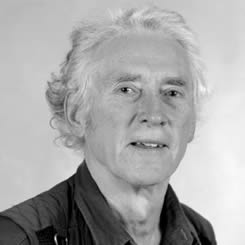

|

|
IN MEMORIAM
Frank S. Crawford
Professor of Physics, Emeritus
UC Berkeley
1923 – 2003
Professor Frank Crawford died on July 28, 2003, at the age of 79. His interests spanned particle physics, astrophysics, and the physics of phenomena experienced in everyday life. He played a key role in many discoveries, was an excellent teacher, and author of a wonderful textbook, Waves, part 3 of the Berkeley Physics Series.
Crawford was born on October 25, 1923. At the age of 21, he was a radio operator in the Army and was shot down over enemy-occupied Yugoslavia. He made contact with the resistance and was secretly taken from farmhouse to farmhouse to safety. He returned to his studies and earned his A.B. and Ph.D. degrees at the University of California, Berkeley. Originally he was a graduate student working for Pief Panofsky and Herbert York; but when they left, he asked Luis Alvarez to be his supervisor. Alvarez agreed, but only on the condition that Crawford treat Alvarez as his student. Crawford turned into one of Alvarez's closest colleagues. Although he was primarily an experimentalist, Crawford was adept at theory. After a course from Fermi, he taught quantum mechanics and relativistic kinematics to the other physicists in Alvarez's group.
He was with Alvarez in Washington when, after a lecture by Don Glaser, they decided to build a liquid hydrogen bubble chamber. He visited Glaser in Michigan to learn everything he could, and he played an important role in this and ensuing work that eventually resulted in a Nobel Prize for Alvarez. Alvarez was generous in his praise of Crawford.
Among Crawford's innovations was the use of scattered electrons (known as delta rays) to determine particle velocities. He and his colleagues made the first measurements of the lifetime of what appeared to be two subnuclear particles, tau and theta, work that led to the discovery of parity nonconservation. He had 23 papers in the prestigious Physical Review Letters. He coauthored the paper that was the first to see parity violation in the lambda hyperon. He participated in the discovery of the delta S = delta Q rule, charge symmetry, the measurement of the magnetic moment of the Lambda, the discovery of the delta I = 1/2 rule, much of K0 physics, eta physics, and the determination of the K1-K2 mass difference.
In the later parts of his career, he moved into astrophysics, working with Richard Muller. He was active in the field of adaptive optics and in 1977 identified the first supernova detected by the Berkeley automated search system. He retired from the University in 1991.
Crawford was a talented musician who loved to play in jazz ensembles. He invented a musical instrument he called a corrugohorn, taught the physics of music, and wrote a record 47 articles for the American Journal of Physics on topics ranging from the sounds of hot chocolate to how pterosaurs could fly. In his sixties, he developed a passion for skydiving. He exhibited a love of physics in all its aspects and a willingness to plunge into any field of science that intrigued him – and nearly all of them did.
Frank Crawford is survived by his wife Elizabeth, his ex-wife Bevalyn, and his children Sarah and Matthew.
Richard A. Muller